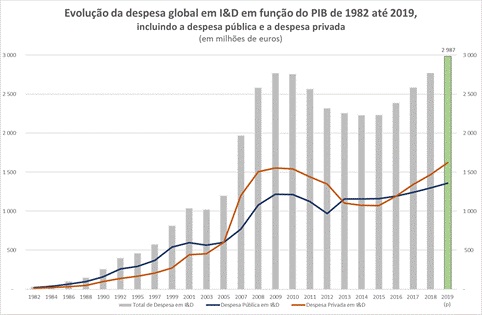R&D investment reaches 2,987 million euros in 2019

Provisional results from the National Scientific and Technological Potential Survey (IPCTN19) show that last year saw the highest investment ever in Research and Development (R&D) in Portugal. Total expenditure on R&D activities reached 2,987 million euros, 218 million euros more than in 2018, representing 1.41% of Gross Domestic Product (GDP). This is the highest ever figure for R&D investment in Portugal.
This increase in investment is particularly significant in the business sector, which grew by 10% between 2018 and 2019, representing 0.74% of GDP in 2019. These figures reinforce the trend of business growth in R&D, which is reflected in the growth of qualified employment in companies and in the private sector's efforts to keep up with scientific development and the technological capacity installed in Portugal.
Higher education also increased its investment in R&D, growing by around 5% in 2019, also reaching a new high of 1,209 million euros.
Another important element in characterizing the scientific and technological system is the number of researchers in the working population, which has also grown. In 2019 there were 10 researchers per 1,000 working people, while in 2018 there were 9.1 per 1,000 working people, in 2017 there were 8.6 and in 2016 there were 8.
In total, 50,431 full-time equivalent (FTE) researchers were registered, 2,779 more than in 2018, reflecting an increase of 11,759 FTE researchers since 2015, i.e. an increase of 30% in the last 4 years. Higher education has 29,027 FTE researchers, representing 58% of the total, while companies have 19,283 FTE researchers, representing 38% of the total. The number of researchers in companies increased by 2,537 FTE, representing an increase of 15% between 2018 and 2019.
In the state sector (which includes state laboratories) there were 1,591 researchers in FTE last year, or 3% of the total.
The total number of human resources in research and development activities (researchers, technicians and other professionals) is 12 people (FTE) per 1,000 active inhabitants.
The provisional results of the IPCTN19 are published by the Directorate-General for Education and Science Statistics (DGEEC) based on methodologies harmonized internationally by EUROSTAT and the OECD.
Graph: source MCTES